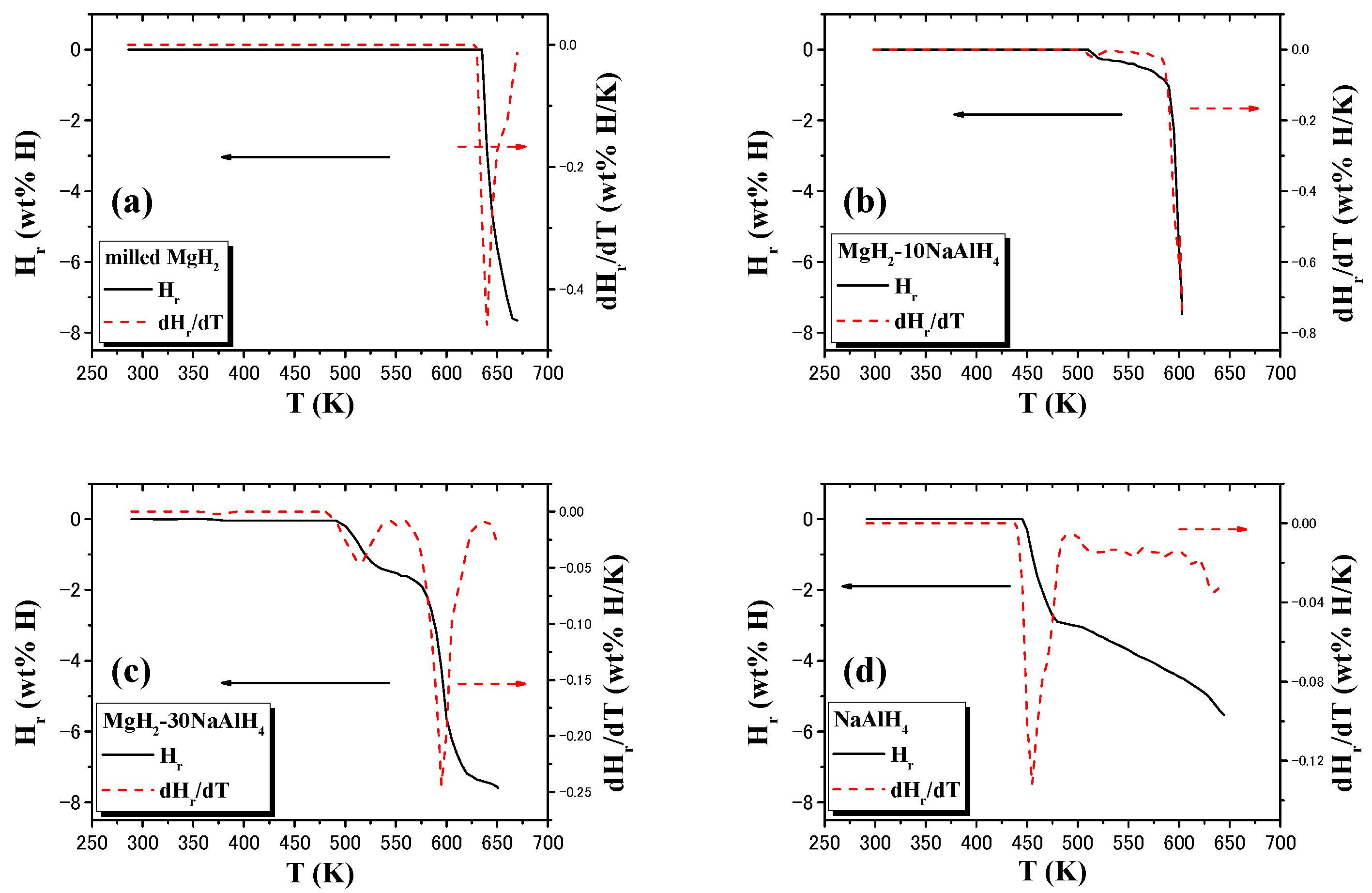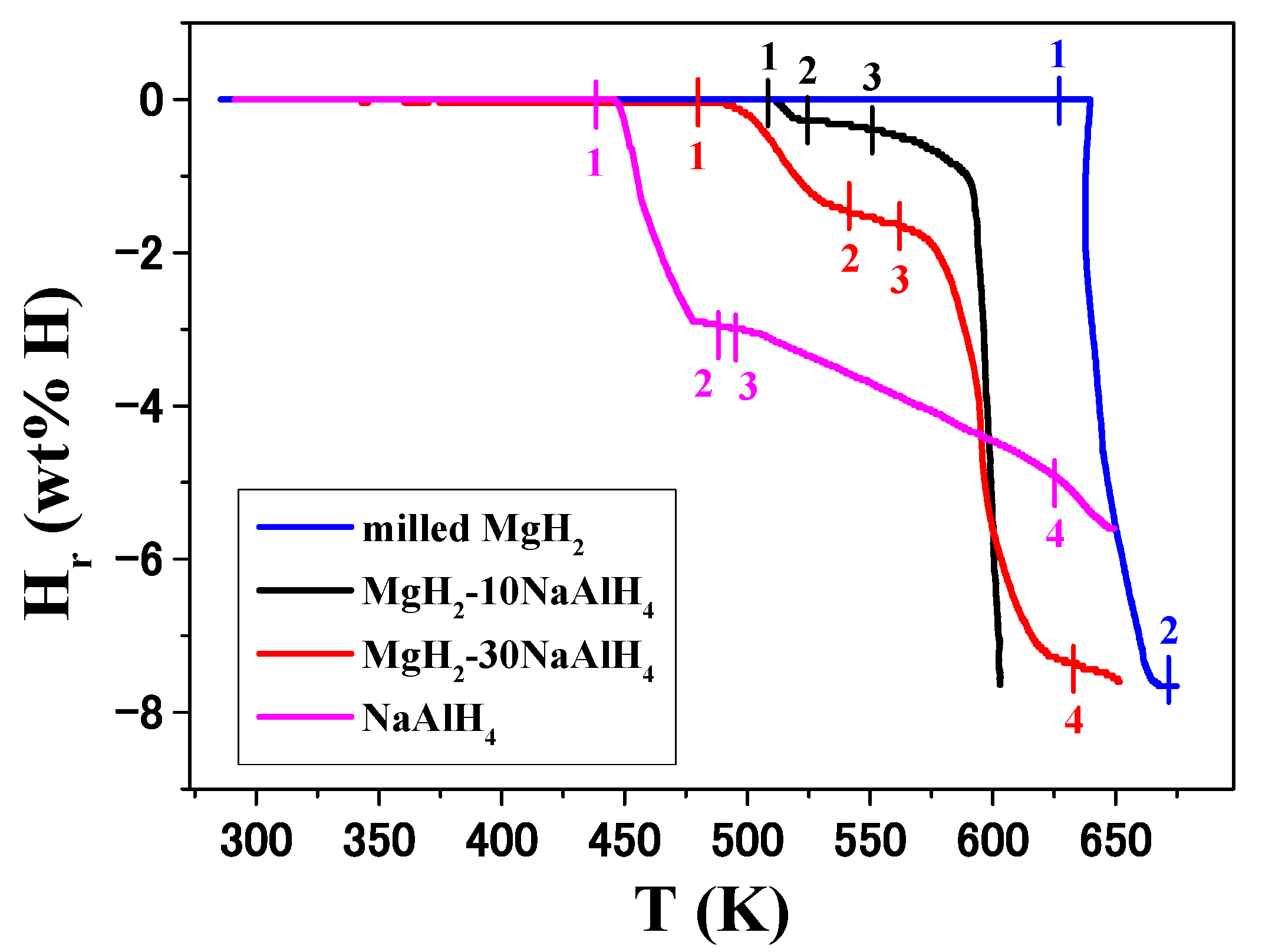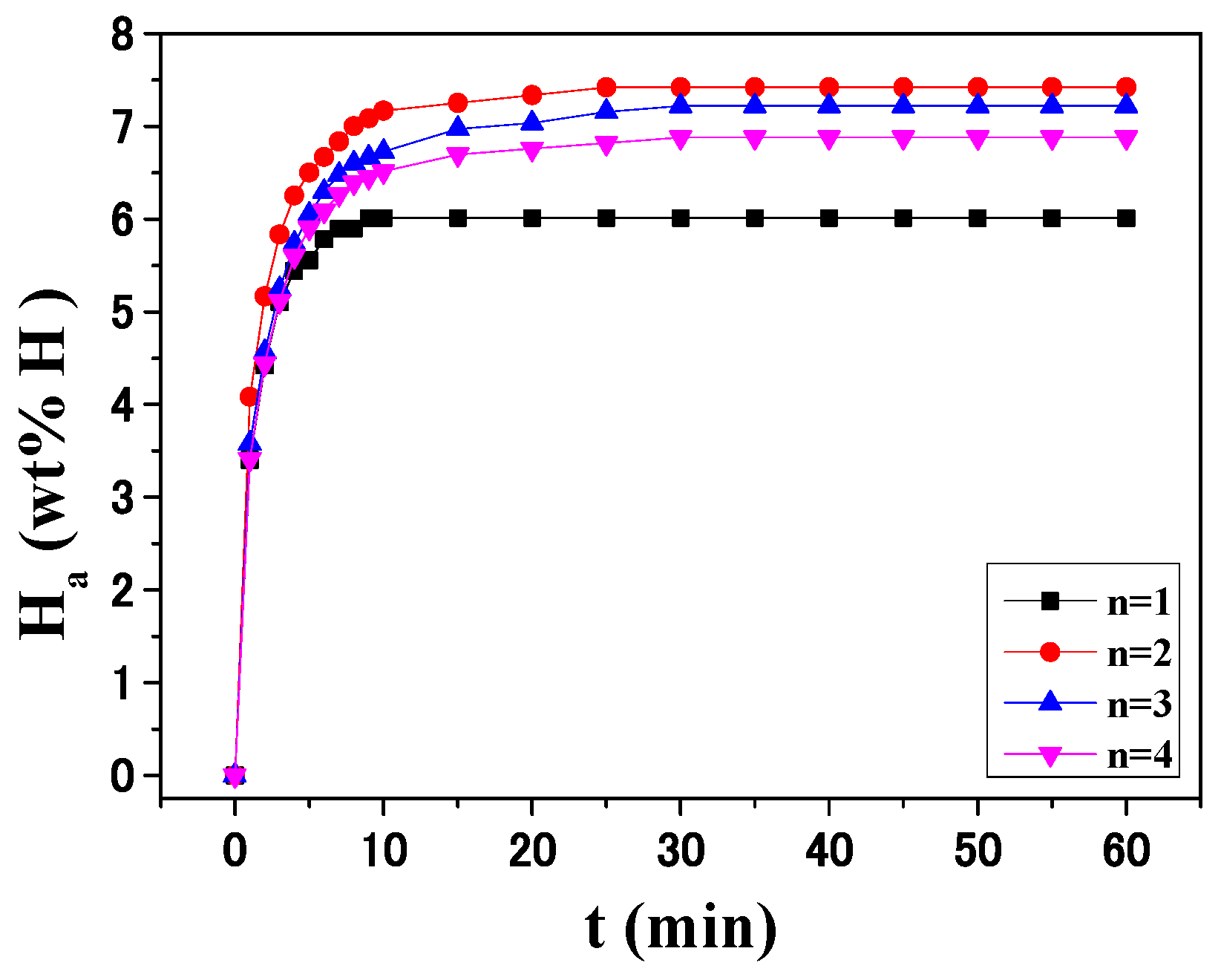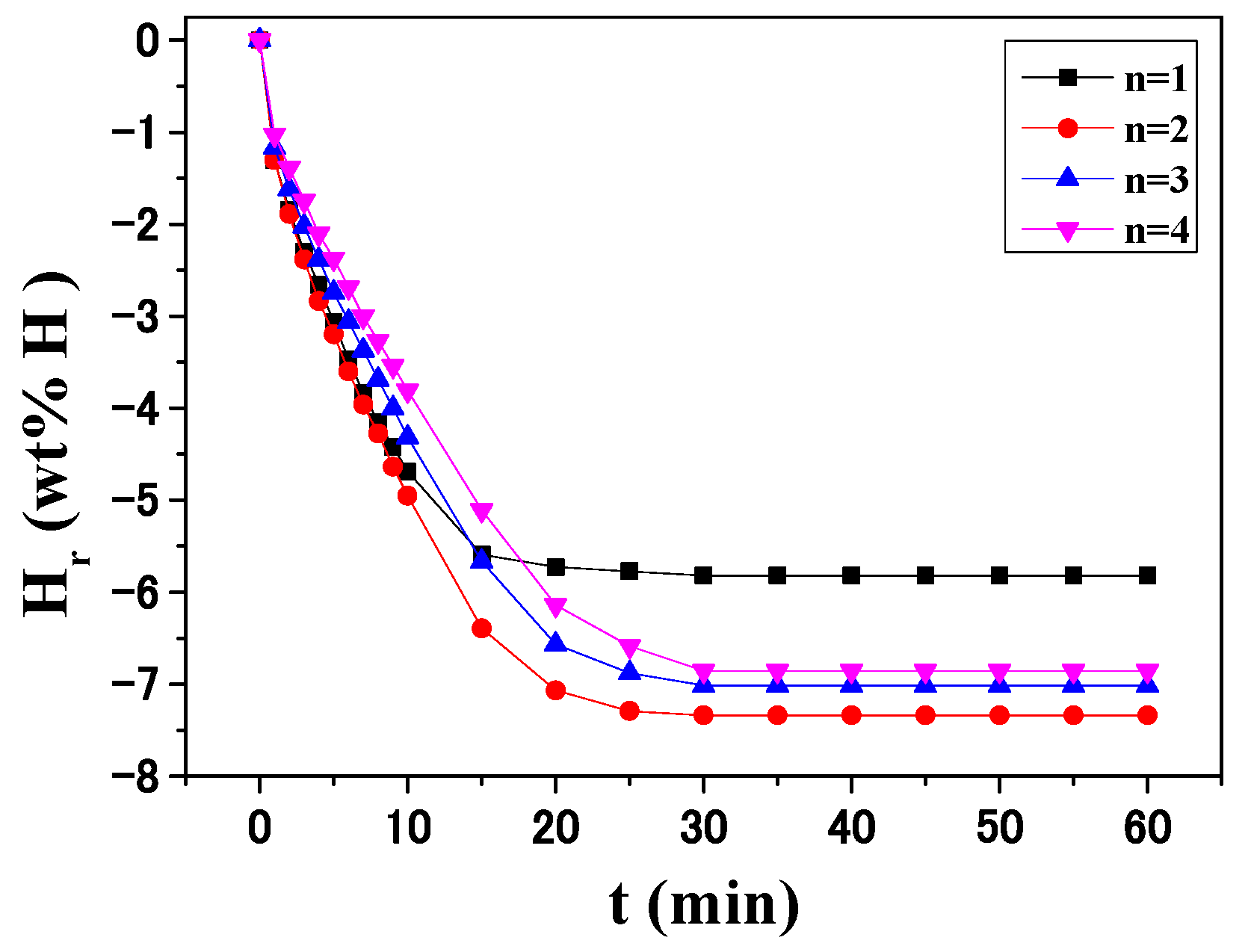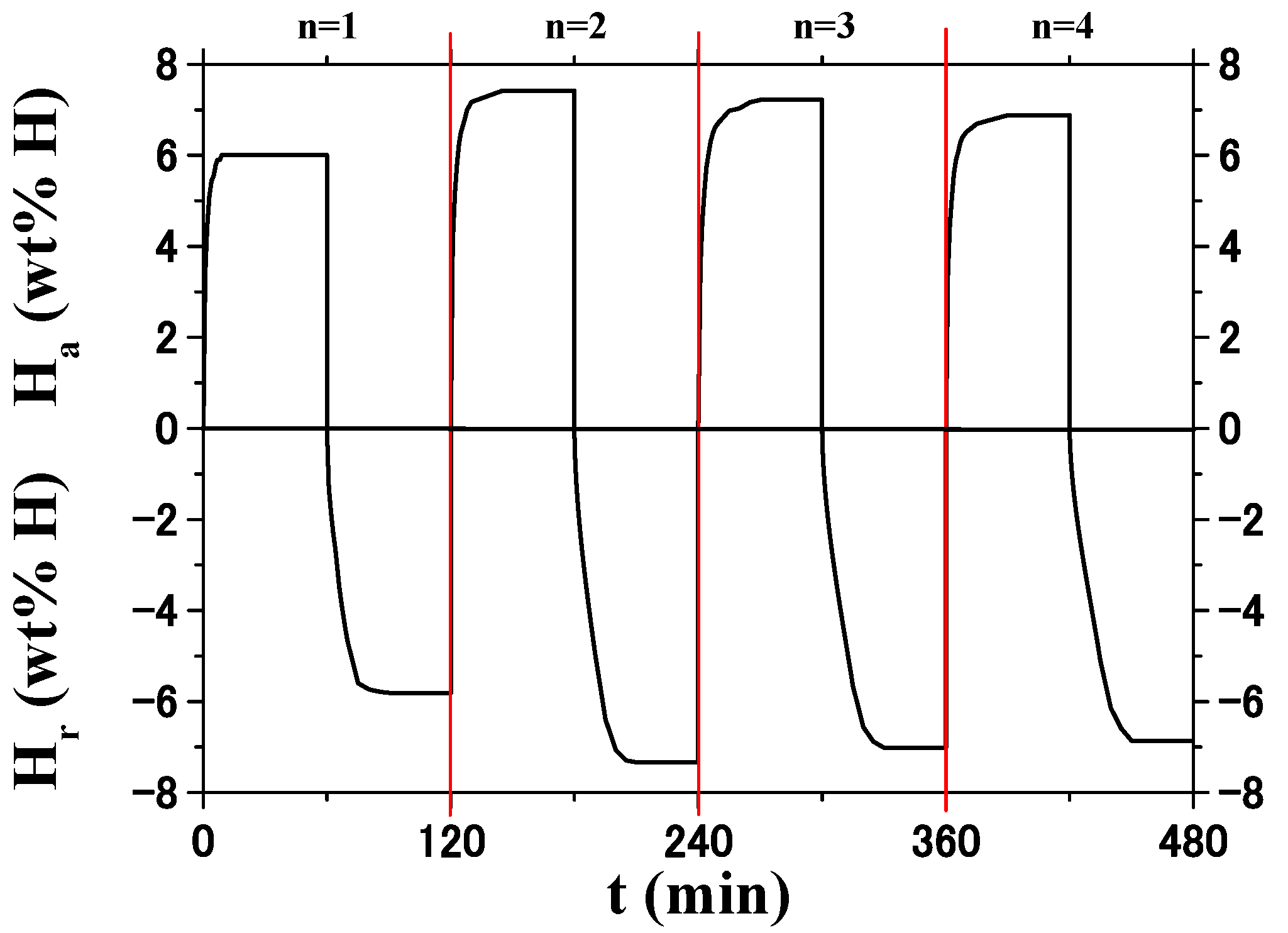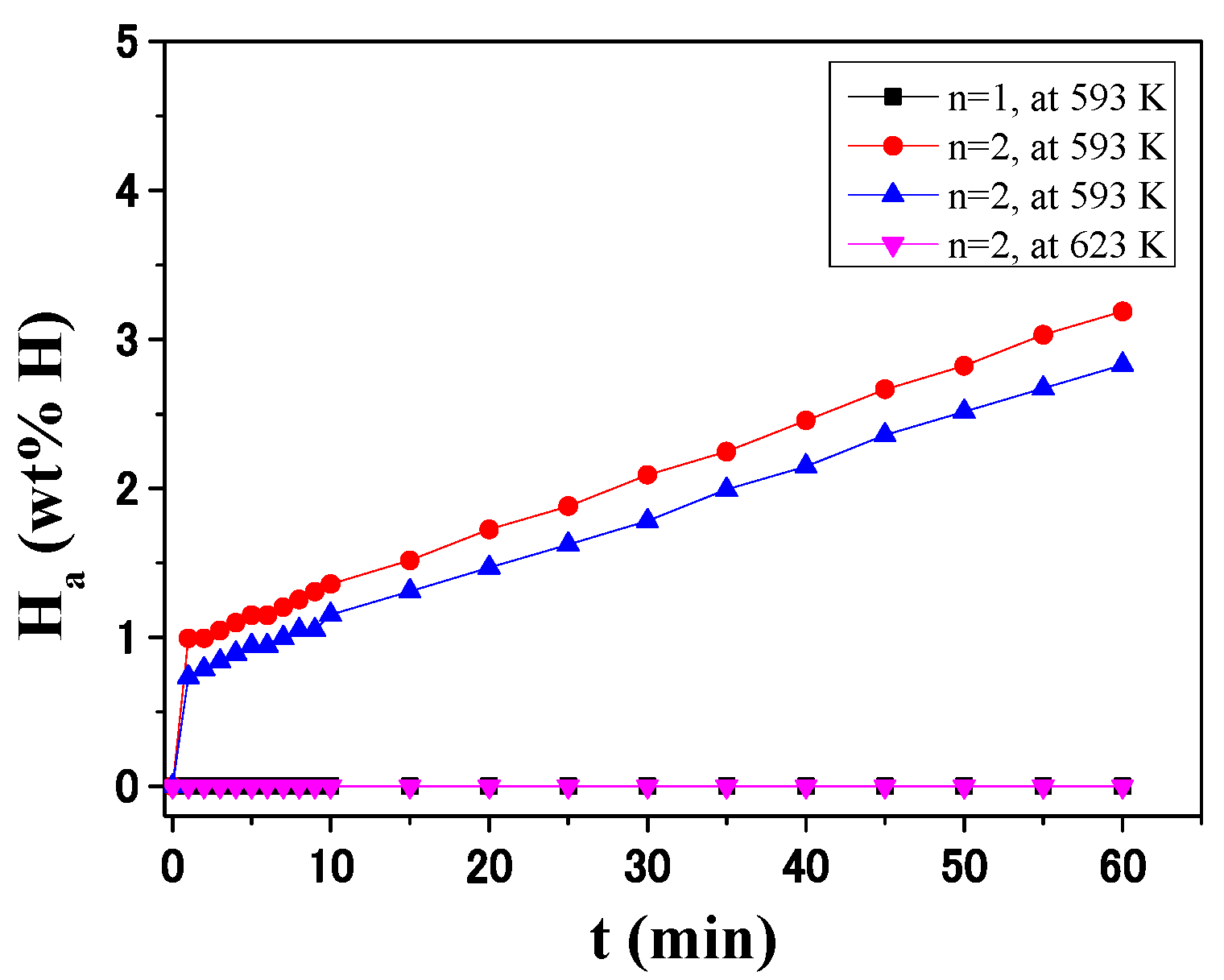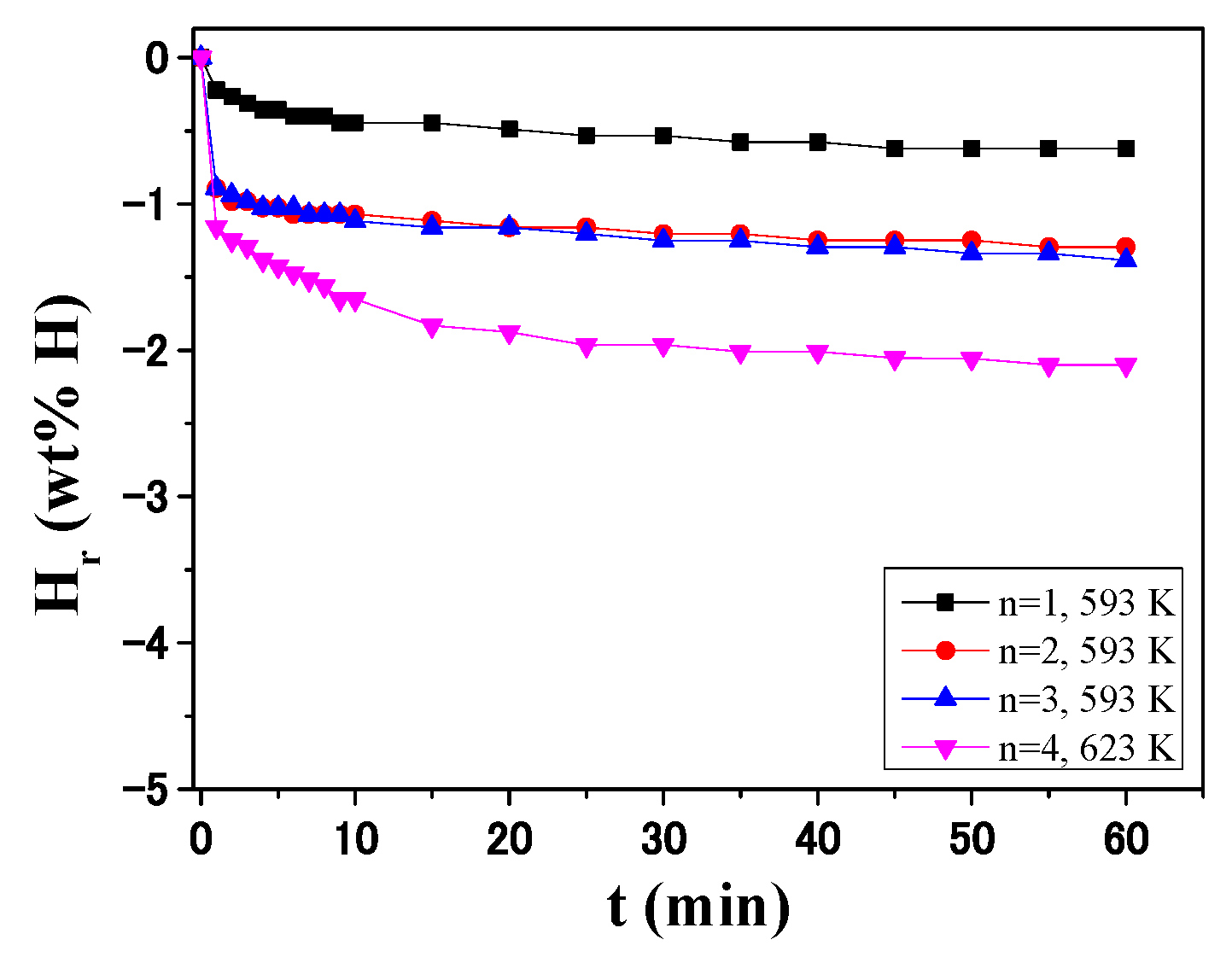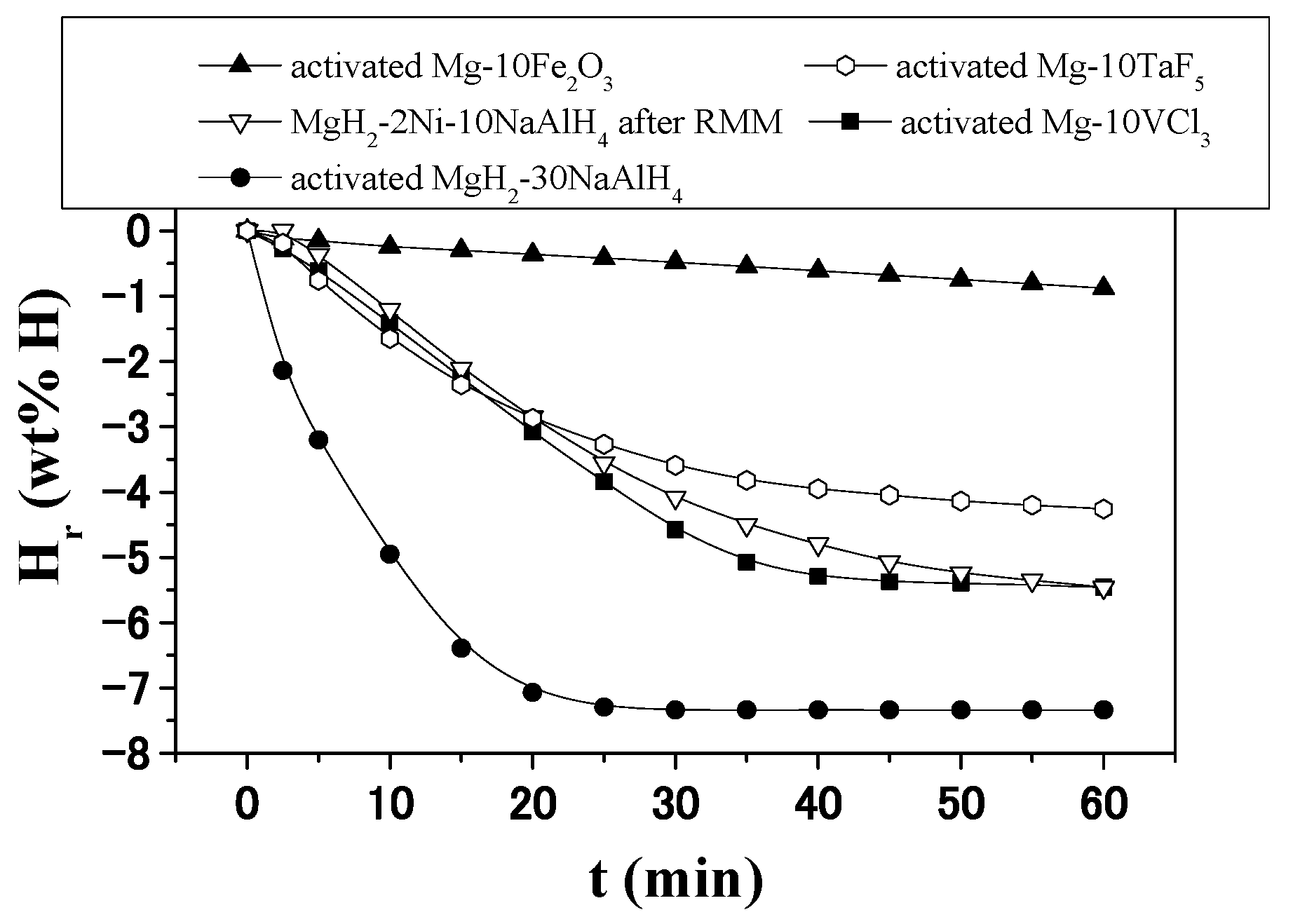1. Introduction
Clean alternative energies have drawn interest in preventing air pollution and climate change. One of the clean alternative energies is hydrogen energy, which is the energy produced by the reaction of hydrogen with oxygen, producing water as a by-product. The problems to be solved for applying hydrogen energy to practical use are hydrogen production and storage.
Hydrogen is usually stored in a gaseous state under high pressure and in a cryogenic liquid state. Storing gaseous hydrogen has disadvantages such as safety issues, high cost, and hydrogen embrittlement of storage tank materials. Storage of hydrogen in a cryogenic liquid state has drawbacks such as thermal losses in the case of an open system, safety, and cost of liquefaction.
Another method to store hydrogen is solid-state hydrogen storage using materials such as metal hydrides. Metal hydrides have advantages such as high gravimetric and volumetric storage capacities and safety, as metal hydrides can absorb and release hydrogen at relatively low pressures. Hydrogen is bound by chemical or physical forces in hydrogen storage based on solid-state materials. The technique of storing hydrogen in a solid state has become very attractive and is the subject of studies by many researchers. We are interested in synthesizing metal hydrides based on a metal, magnesium (Mg). Mg-based hydrides have relatively high reaction rates and high hydrogen storage capacities.
Complex hydrides such as LiBH
4 and NaAlH
4 have been studied by many researchers because they have high theoretical hydrogen storage capacities [
1,
2,
3,
4,
5,
6,
7,
8,
9,
10]. Many works were performed to improve the hydriding and dehydriding kinetics of Mg [
11,
12,
13,
14,
15,
16]. Researchers were interested in improving the hydrogen storage properties of MgH
2 by adding NaAlH
4 with a high hydrogen storage capacity [
17,
18,
19,
20,
21]. Ali and Ismail [
17] reviewed the hydrogen storage properties of the Mg–Na–Al system. The complex hydride NaAlH
4 releases hydrogen via three-step reactions:
Ali and Ismail [
17] reported that the addition of NaAlH
4 could destabilize the MgH
2 effectively and the hydrogen storage properties of NaAlH
4 could also be improved by adding MgH
2. The MgH
2-NaAlH
4 system exhibited much better dehydriding properties than unary MgH
2 and NaAlH
4.
Ismail et al. [
20] reported that the following reaction takes place within the temperature range from 443 to 485 K:
A mixing decomposition of the reaction of MgH
2 with Al (4) and the decomposition of the excessive MgH
2 (5) occurs reversibly between 553 K and 603 K [
20].
They also reported that NaMgH
3 decomposes between 603 K and 633 K by the following reversible reaction:
NaH decomposes between 633 K and 648 K by the following reversible reaction [
20]:
In the present work, samples with various compositions were prepared and many phenomena were examined such as decomposition temperatures, phase formation, hydrogen absorption and release rates, and hydrogen storage capacity. In addition, the hydrogen storage properties of the prepared samples were compared with those of other Mg-based alloys. In particular, the decomposition temperatures were measured in the Sieverts-type hydrogen absorption and release apparatus, in which the samples were hydrided and dehydrided, by heating the samples at a constant heating rate and simultaneously measuring the released hydrogen quantity. In other researchers’ work, the decomposition temperatures were usually measured in thermal analysis instruments such as thermal gravimetric analysis (TGA) and differential scanning calorimetry (DSC). Milled MgH2, MgH2-10NaAlH4 (with a composition of 90 wt% MgH2 + 10 wt% NaAlH4), MgH2-30NaAlH4 (70 wt% MgH2 + 30 wt% NaAlH4), MgH2-50NaAlH4 (50 wt% MgH2 + 50 wt% NaAlH4), and MgH2-2Ni-10NaAlH4 (88 wt% MgH2 + 2 wt% Ni + 10wt% NaAlH4) samples were prepared by milling in a planetary ball mill in hydrogen atmosphere (reactive mechanical milling, RMM). Decomposition temperatures of milled MgH2, NaAlH4, MgH2-10NaAlH4, and MgH2-30NaAlH4 were examined by heating at a rate of 5∼6 K/min in a Sieverts-type hydrogen absorption and release apparatus and phase formation in cycled MgH2-50NaAlH4 were investigated.
3. Results
The quantity of released hydrogen, Hr (wt% H), was calculated using the sample weight as a standard.
Figure 1 shows the quantity of released hydrogen (H
r) versus temperature (T) curves and the ratio of increase in H
r to increase in T, dH
r/dT, versus T curves for milled MgH
2, MgH
2-10NaAlH
4, MgH
2-30NaAlH
4, and NaAlH
4 samples. The samples were heated at a heating rate of 5∼6 K/min in 1.0 bar hydrogen.
Table 1 presents the temperatures (K) at peaks in the dH
r/dT versus T curves for milled MgH
2, MgH
2-10NaAlH
4, MgH
2-30NaAlH
4, and NaAlH
4 samples. The highest peaks appear at 638, 600, 592, and 455 K, respectively, for milled MgH
2, MgH
2-10NaAlH
4, MgH
2-30NaAlH
4, and NaAlH
4.
Figure 2 shows the quantity of released hydrogen (H
r) versus temperature (T) curves for milled MgH
2, MgH
2-10NaAlH
4, MgH
2-30NaAlH
4, and NaAlH
4 samples. The samples were heated at a heating rate of 5∼6 K/min in 1.0 bar hydrogen. The points 1, 2, 3, and 4 were marked so that they correspond to the beginning and ending points of the peaks in
Figure 1.
Table 2 presents the temperatures (K) at the marked points in the H
r versus T curves for milled MgH
2, MgH
2-10NaAlH
4, MgH
2-30NaAlH
4, and NaAlH
4 samples.
Hydrogen release begins at 627 K for the as-milled MgH2. Hydrogen release from the NaAlH4 begins at 438 K and the slope of the Hr versus T curve then changes at 488, 495, and 625 K. MgH2-10NaAlH4 begins to release hydrogen at 508 K and slopes of the Hr versus T curves change at 525 K and 550 K. MgH2-30NaAlH4 begins to release hydrogen at 480 K and slopes of the Hr versus T curves change at 541, 562, and 633 K.
As the content of NaAlH4 in the sample increases, the temperature at the highest peak decreases. The higher content of NaAlH4 is believed to strengthen the effects of reactive mechanical grinding, lowering the temperatures for the reaction. The effects of reactive mechanical milling are thought to be the creation of defects, making clean surfaces and cracks, and decreasing particle sizes.
The XRD pattern of MgH
2-50NaAlH
4 dehydrided after the number of cycles, n, of 4 at 593 K is shown in
Figure 3. The sample contains Al, MgO, Al
3Mg
2, NaH, and Mg
17Al
12. Al, formed from the reaction (4), is believed to react with Mg (formed by the decomposition of MgH
2) and form Al
3Mg
2 and Mg
17Al
12. The Mg
17Al
12 phase belongs to the body-centered cubic system with a space group of I-43m (No. 217). Samples were easily ignited on exposure to the oxygen in the air to obtain the XRD pattern. This led to the formation of a strong peak of MgO and relatively weak peaks of other phases. The broad peak of MgO shows that the particles of MgO are very fine. The large width of the peaks also suggests that the sample has many defects. In the XRD pattern of pure MgH
2, MgO was not found. However, in the XRD pattern of MgH
2-50NaAlH
4 after cycling four times, MgO was observed. It is thought that MgO is formed when the sample is exposed to air to obtain the XRD pattern because the particles of the sample are very fine and the surface of the particles are very clean and reactive.
Liu et al. [
22] reported that when the temperature is increased to 633 K, a large amount of hydrogen is released, and two new phases, Mg
17Al
12 and Mg, are formed while the preformed Al and Al
3Mg
2 disappear.
Figure 4 shows the change of H
a versus time t curve at 593 K in 12 bar hydrogen with cycle number, n, for MgH
2-30NaAlH
4. The effective hydrogen storage capacity is defined as the quantity of hydrogen absorbed for 60 min (wt% H). As n increases from one to two, the hydrogen absorption rate for 1 min increases. From n = 2 to n = 4, the hydrogen absorption rate for 1 min decreases. In a similar way, the effective hydrogen storage capacity increases as n increases from one to two, and from n = 2 to n = 4, the effective hydrogen storage capacity decreases. The activation is considered to have been completed after n = 2. At n = 2, MgH
2-30NaAlH
4 absorbs 4.09 wt% H for 1 min, 7.17 wt% H for 10 min, and 7.42 wt% H for 60 min.
The change of the H
r versus t curve at 593 K in 1.0 bar hydrogen with n for MgH
2-30NaAlH
4 is shown in
Figure 5. As the number of cycles (n) increases from one to four, the hydrogen release rate for 1 min decreases. The hydrogen release rate for 1 min at n = 1 and n = 2 are very similar. The quantity of hydrogen released for 60 min increases as n increases from one to two, and from n = 2 to n = 4 the quantity of hydrogen released for 60 min decreases. At n = 2, MgH
2-30NaAlH
4 releases 1.31 wt% H for 1 min, 4.95 wt% H for 10 min, and 7.34 wt% H for 60 min.
Figure 6 shows changes in the H
a versus time t curve at 593 K in 12 bar hydrogen and H
r versus t curve at 593 K in 1.0 bar hydrogen with cycle number, n, for MgH
2-30NaAlH
4. The curves show that activation is completed after n = 2, showing the highest hydrogen absorption rate, the highest hydrogen release rate, the largest effective hydrogen storage capacity, and the largest quantity of hydrogen released for 60 min. The curves after completion of activation show that MgH
2-30NaAlH
4 has good reversibility and round-trip energy efficiency.
The H
a versus t curves in 12 bar hydrogen at 593 K or 623 K at n = 1 and n = 2 for MgH
2-50NaAlH
4 are shown in
Figure 7. Because the hydrogen absorption rate was low, experiments were performed several times. Even though the samples were handled in an Ar atmosphere, the samples were ignited partly, leading to low hydrogen absorption rates and low effective hydrogen storage capacities. For n = 1 at 593 K, the MgH
2-50NaAlH
4 sample does not absorb hydrogen. For n = 2 at 623 K, the MgH
2-50NaAlH
4 sample does not absorb hydrogen either, probably because the difference between the applied hydrogen pressure (12 bar) and the equilibrium plateau pressure at 623 K (6.38 bar [
23]) of the Mg-H system is small. At n = 2, the MgH
2-50NaAlH
4 sample absorbs 0.99 wt% H for 1 min, 1.36 wt% H for 10 min, and 3.19 wt% H for 60 min at 593 K.
Figure 8 shows the H
r versus t curves in 1.0 bar hydrogen at 593 K or 623 K at n = 1∼4 for MgH
2-50NaAlH
4. Hydrogen release rates are low and the quantities of hydrogen released for 60 min are small. As n increases, the initial hydrogen release rate and the quantity of hydrogen released for 60 min increase slightly. At n = 2, the MgH
2-50NaAlH
4 sample releases 1.03 wt% H for 5 min and 1.29 wt% H for 60 min at 593 K. When the temperature increases from 593 K to 623 K, the initial hydrogen release rate and the quantity of hydrogen released for 60 min increase slightly. Partial ignition in the samples led to low initial hydrogen release rates and small quantities of hydrogen released for 60 min.
During hydrogen absorption (
Figure 3) and release (
Figure 4), reactions (5) and (6) are believed to occur.
H
a versus t curves in 12 bar hydrogen at 593 K for activated MgH
2-30NaAlH
4, MgH
2-2Ni-10NaAlH
4 after RMM, activated Mg-10Fe
2O
3 [
24,
25], activated Mg-10TaF
5 [
26,
27], and activated Mg-10VCl
3 [
28] are shown in
Figure 9. The Mg-10Fe
2O
3 [
24,
25], Mg-10TaF
5 [
26,
27], and Mg-10VCl
3 [
28] samples were also prepared by RMM under conditions similar to those for preparing MgH
2-30NaAlH
4 and MgH
2-2Ni-10NaAlH
4. MgH
2-2Ni-10NaAlH
4 did not require activation after reactive mechanical milling (RMM). The H
a versus t curve of MgH
2-2Ni-10NaAlH
4 after RMM is used for comparison with the H
a versus t curves of other activated samples. Activated MgH
2-30NaAlH
4 has the highest hydrogen absorption rate for 2.5 min, followed in order by MgH
2-2Ni-10NaAlH
4 after RMM, activated Mg-10VCl
3, activated Mg-10TaF
5, and activated Mg-10Fe
2O
3. Activated MgH
2-30NaAlH
4 has the highest effective hydrogen storage capacity, followed in order by activated Mg-10VCl
3, MgH
2-2Ni-10NaAlH
4 after RMM, activated Mg-10Fe
2O
3, and activated Mg-10TaF
5. MgH
2-30NaAlH
4 has a much higher hydrogen absorption rate for 2.5 min (2.20 wt% H/min) and a much larger effective hydrogen storage capacity (7.42 wt% H) than the other samples.
Figure 10 shows H
r versus t curves in 1.0 bar hydrogen at 593 K for activated MgH
2-30NaAlH
4, MgH
2-2Ni-10NaAlH
4 after RMM, activated Mg-10Fe
2O
3 [
24,
25], activated Mg-10TaF
5 [
26,
27], and activated Mg-10VCl
3 [
28]. Activated MgH
2-30NaAlH
4 has the highest hydrogen release rate for 2.5 min, followed in order by activated Mg-10VCl
3, activated Mg-10TaF
5, MgH
2-2Ni-10NaAlH
4 after RMM, and activated Mg-10Fe
2O
3. Activated MgH
2-30NaAlH
4 has the largest quantity of hydrogen released for 60 min, followed in order by activated Mg-10VCl
3, MgH
2-2Ni-10NaAlH
4 after RMM, activated Mg-10TaF
5, and activated Mg-10Fe
2O
3, and activated. MgH
2-30NaAlH
4 has a much higher hydrogen release rate for 2.5 min (0.86 wt%/min) and a much larger quantity of hydrogen released for 60 min (7.34 wt% H) than the other samples.
Table 3 shows hydrogen absorption properties in 12 bar hydrogen at 593 K for activated MgH
2-30NaAlH
4, MgH
2-2Ni-10NaAlH
4 after RMM, activated Mg-10Fe
2O
3 [
24], activated Mg-10TaF
5 [
26], and activated Mg-10VCl
3 [
28]. Numbers in parentheses indicate rankings. H
a (x min) (wt% H) means the quantity of hydrogen absorbed for x min. The initial hydrogen absorption rate is defined as the hydrogen absorption rate during 2.5 min and calculated by dividing H
a (2.5 min) by 2.5 min. Activated MgH
2-30NaAlH
4 has the highest initial hydrogen absorption rate, followed in order by MgH
2-2Ni-10NaAlH
4 after RMM, activated Mg-10VCl
3, activated Mg-10TaF
5, and activated Mg-10Fe
2O
3. Activated MgH
2-30NaAlH
4, MgH
2-2Ni-10NaAlH
4 after RMM, and activated Mg-10VCl
3 have relatively large values of H
a (10 min). Activated MgH
2-30NaAlH
4 has the highest effective hydrogen storage capacity, followed in order by MgH
2-2Ni-10NaAlH
4 after RMM, activated Mg-10VCl
3, activated Mg-10Fe
2O
3, and activated Mg-10TaF
5.
Table 4 shows hydrogen release properties in 1.0 bar hydrogen at 593 K for activated MgH
2-30NaAlH
4, MgH
2-2Ni-10NaAlH
4 after RMM, activated Mg-10Fe
2O
3 [
24], activated Mg-10TaF
5 [
26], and activated Mg-10VCl
3 [
28]. H
r (x min) (wt% H) means the quantity of hydrogen released for x min. The initial hydrogen release rate is defined as the hydrogen release rate during 2.5 min and calculated by dividing H
r (2.5 min) by 2.5 min. Activated MgH
2-30NaAlH
4 has the highest initial hydrogen release rate, followed in order by activated Mg-10VCl
3 and activated Mg-10TaF
5. The initial hydrogen release rates of MgH
2-2Ni-10NaAlH
4 after RMM and activated Mg-10Fe
2O
3 are zero. Activated MgH
2-30NaAlH
4 has a large value of H
r (10 min). Activated Mg-10TaF
5, activated Mg-10VCl
3, and MgH
2-2Ni-10NaAlH
4 after RMM have relatively large values of H
r (10 min). Activated MgH
2-30NaAlH
4 has the largest H
r (60 min), followed in order by MgH
2-2Ni-10NaAlH
4 after RMM, activated Mg-10VCl
3, activated Mg-10TaF
5, and activated Mg-10Fe
2O
3.
Table 5 summarizes reversibility, cyclability, round-trip energy efficiency, and general practicability for activated MgH
2-30NaAlH
4, MgH
2-2Ni-10NaAlH
4 after RMM, activated Mg-10Fe
2O
3, activated Mg-10TaF
5, and activated Mg-10VCl
3. Reversibility (%) is defined as 100 × H
r (60 min)/H
a (60 min) after activation. Cyclability (wt% H/cycle) is defined as the increase in H
a (60 min) per cycle from n =1 to n = 4. Round-trip energy efficiency is defined as H
r (60 min)/H
a (60 min) after activation. General practicability is indicated in ranking by considering all the properties in
Table 3,
Table 4 and
Table 5. Activated MgH
2-30NaAlH
4 has the best reversibility, cyclability, and round-trip energy efficiency, followed in order by MgH
2-2Ni-10NaAlH
4 after RMM, activated Mg-10VCl
3, activated Mg-10TaF
5, and activated Mg-10Fe
2O
3. The cyclability of activated MgH
2-30NaAlH
4 is positive, showing that H
a (60 min) increases roughly from n = 1 to n = 4.
Activated MgH2-30NaAlH4 has the best general practicability, followed in order by MgH2-2Ni-10NaAlH4 after RMM, activated Mg-10VCl3, activated Mg-10TaF5, and activated Mg-10Fe2O3. MgH2-2Ni-10NaAlH4 after RMM has a slightly better general practicability than activated Mg-10VCl3.
Activated MgH2-30NaAlH4 has an initial hydrogen absorption rate of 2.20 wt% H/min (vs. 1.26 wt% H/min for activated Mg-10VCl3), Ha (10 min) of 7.17 wt% H (vs. 5.15 wt% H for activated Mg-10VCl3), an effective hydrogen storage capacity of 7.42 wt% H (vs. 5.56 wt% H for activated Mg-10VCl3).
Activated MgH2-30NaAlH4 has an initial hydrogen release rate of 0.95 wt% H/min (vs. 0.08 wt% H/min for activated Mg-10VCl3), Hr (10 min) of 4.95 wt% H (vs. 1.32 wt% H for activated Mg-10VCl3), an Hr (60 min) of 7.34 wt% H (vs. 5.42 wt% H for activated Mg-10VCl3).
Cyclability in
Table 4 is examined only from n = 1 to n = 4. The cyclability of a sample MgH
2-2Ni-10NaAlH
4 was examined from n = 1 to n = 30 under 12 bar for hydrogen absorption and 1.0 bar H
2 for hydrogen release at 593 K. MgH
2-2Ni-10NaAlH
4 had H
a (60 min) values of 5.62 wt% H at n =1 and 5.36 wt% H at n = 30, showing the good cyclability of −0.009 wt% H/cycle. The lifetimes of the samples were not investigated. We will examine the lifetimes of the samples in future research.
4. Discussion
From the results of
Figure 2, it is believed that for the NaAlH
4, reaction (1) (decomposition of NaAlH
4) begins to occur at 438 K, and reaction (2) (decomposition of Na
3AlH
6) begins to occur at 495 K. For the MgH
2-10NaAlH
4 sample, it is believed that reaction (4) occurs between point 1 (508 K) and point 2 (525 K), reactions (5) and (6) begin to occur after point 3 (550 K), and then reaction (7) and reaction (8) occur consecutively. For the MgH
2-30NaAlH
4 sample, it is believed that reaction (4) occurs between point 1 (480 K) and point 2 (541 K), reactions (5) and (6) begin to occur after point 3 (562 K), and then reaction (7) and reaction (8) occur consecutively. The reaction (4) for the MgH
2-30NaAlH
4 begins to occur at 28 K lower temperature than that for the MgH
2-10NaAlH
4.
Samples were easily ignited on exposure to air, making the obtention of XRD patterns difficult and leading to the formation of a strong peak of MgO and relatively weak peaks of other phases. Liu et al. [
22] reported that when the temperature is increased to 633 K, the preformed Al and Al
3Mg
2 disappear. In
Figure 3 (the XRD pattern of MgH
2-50NaAlH
4 dehydrided after the number of cycles, n, of 4 at 593 K), the Al
3Mg
2 phase is observed. The dehydriding temperature (593 K) lower than that in the work of Liu et al. [
22] is believed to have led to this result.
As the content of NaAlH4 in the sample increases, the temperature at the highest peak in the ratio of increase in Hr to increase in T, dHr/dT, versus T curve decreases. The higher content of NaAlH4 is believed to strengthen the effects of reactive mechanical milling. However, too much content of NaAlH4 (as in MgH2-50NaAlH4) leads to worse hydrogen storage properties (hydrogen absorption rate, hydrogen release rate, and hydrogen storage capacity).
From the results of this work and the reported study [
20], it is believed that hydriding in 12 bar hydrogen and dehydriding in 1.0 bar hydrogen at 593 K of MgH
2-30NaAlH
4 are performed by the reversible reactions MgH
2 ⇔ Mg + H
2 and 17MgH
2 + 12Al ⇔ Mg
17Al
12 + 17H
2.
In a planetary ball mill, each jar is located on a circular platform (sun wheel). When the sun wheel turns, the jar rotates around its own axis in the opposite direction. The resulting centrifugal and acting acceleration forces lead to strong grinding effects. RMM can break thin surface oxides and expose fresh metallic surfaces, which are reactive. RMM can also introduce defects and cracks. The propagation of cracks, due to additives acting as the center of stress, makes the particles finer. Defects can be used as the sites active for nucleation. The exposed fresh metallic surfaces and created cracks and surfaces have high reactivity. A decrease in particle size reduces the diffusion distance of hydrogen atoms. The added materials and formed phases are believed to strengthen the effects of RMM. The expansion of the lattice due to hydrogen absorption and the contraction of the lattice due to hydrogen release causes effects similar to those of RMM. However, the effects of lattice expansion and contraction will be weaker than those of RMM. The MgH
2-30NaAlH
4 sample has a higher hydrogen absorption rate for 2.5 min, a larger effective hydrogen storage capacity, a higher hydrogen release rate for 2.5 min, and a larger quantity of hydrogen released for 60 min than the other samples, showing that the effects of RMM and hydrogen absorption release cycling are stronger in the MgH
2-30NaAlH
4 sample, compared with those for the other samples. Reportedly, nucleation can be facilitated by creating active nucleation sites by mechanical treatment and/or alloying with additives [
29]; the diffusion distance of hydrogen can also be decreased by the mechanical treatment and/or alloying of Mg with additives, thereby reducing the magnesium particle size [
30]. In addition, hydrogen mobility can be improved by additives that create microscopic paths of hydrogen [
30]; a rough surface of magnesium particles having many cracks and defects is thus considered more advantageous for hydrogen absorption [
31].
In our future work, milled NaAlH4 will be prepared by reactive mechanical milling. The quantity of released hydrogen (Hr) versus temperature T curve and the ratio of increase in Hr to increase in T, dHr/dT, versus the T curve for the milled NaAlH4, will be obtained and studied in detail. Behaviors of the milled NaAlH4, which are different from those of NaAlH4, are expected.
As shown in
Figure 9 and
Figure 10, the additional effects of NaAlH
4, oxide, halides, or fluoride on MgH
2 or Mg are different. Which kinds of properties such as physical properties (hardness, toughness, surface area, microstructure, etc.) and chemical properties affect the hydrogen storage properties will be investigated in future work.
